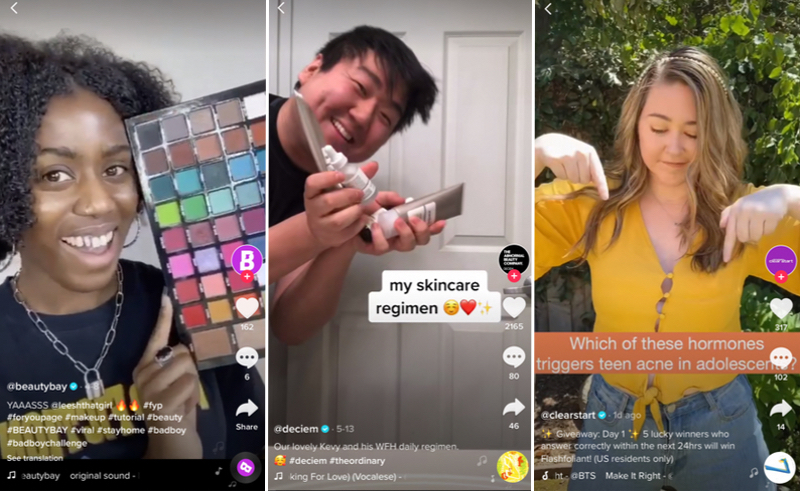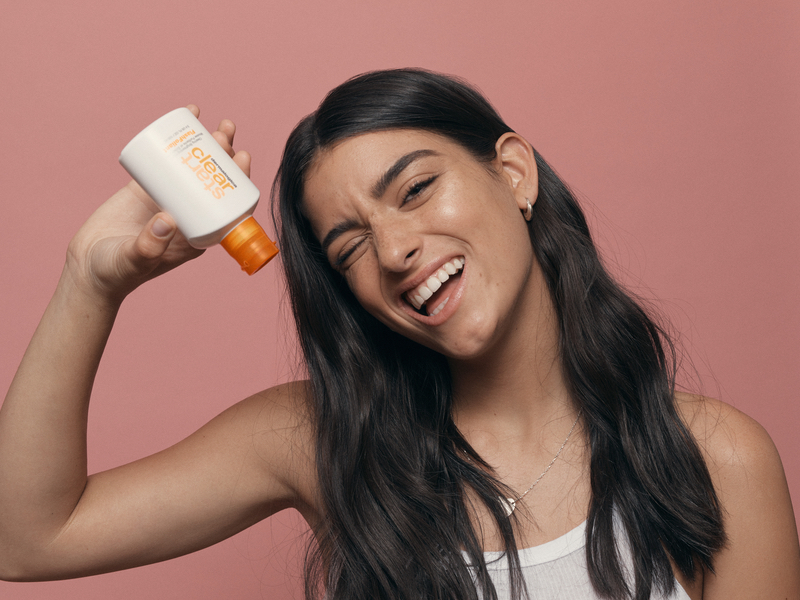Deciem debuted its AHA 30% + BHA 2% Peeling Solution in 2017, but it wasn't until the worldwide launch of TikTok, one year later, that the face mask became an online sensation. A teenager inadvertently earned the maker of The Ordinary a 426% sales spike after a TikTok video she shared using the product went viral.
The visually striking blood-red mask was bought by 100,000 users in the six days after acne-sufferer Kaelyn White posted a video to the social media platform revealing her results.
Popular among Gen Z (under-24s) since its inception, TikTok was founded by Chinese technology firm ByteDance in 2016 and has become the star social media app of 2020, as millennial consumers turned to escapism during the coronavirus pandemic.
This year, tech analyst Sensor Tower reported that TikTok reached the two billion download mark accumulating more than 315 million installs in Q1 as its users diversified and consumers looked for new ways to pass the time, shop and connect. The playful app – content ranges from viral dance challenges and carving watermelons to Harry Styles and quickchange make-up looks – is the third most downloaded app, surpassing Instagram and Facebook.
As consumers flock to TikTok to get their kicks during what is likely to be for many, a holiday-free summer, beauty brands are hoping to cash in. To cater for the forecasted surge of advertisers, in June the app debuted its marketing platform TikTok For Business that allows brands to collaborate with influencers and develop bespoke content.
"TikTok is a hive of fun, creativity and authenticity, so any beauty brand looking at TikTok – whether to dip their toe or dive straight in – needs to understand that first and foremost," explains Anastasia Nicholl, Beauty Lead, Global Business Solutions of TikTok to Cosmetics Business.
"The beauty community on TikTok loves everything from tips and tutorials through to beauty inspiration with a unique spin that showcases an individuals' creativity and individualism.
"There is huge diversity of content and people can move through their feed quickly, which in turn means that the best strategy for beauty brands is to be authentic and focus on original content that feels native to TikTok."

Images via TikTok/BeautyBay, Deciem, Clear Start
Rehashing content from Instagram is not enough on TikTok as Dionne Lois Cullen, Deciem's VP of Brand, experienced when the company launched its active account in February.
"We repurposed some videos from the Deciem Instagram which were not so well received on TikTok, with some users saying 'you don't need to make ads because we love your brand already'," she says.
"The manicured nature of the content wasn't appropriate for the platform. Now the majority of our TikTok content is created by our team on iPhone."
On Instagram, to gain any traction, content should focus on high production imagery that ties in with an aspirational curated feed. Brands are also urged to spend a lot of money with the platform to gain visibility. Whereas popular content on TikTok is less about looking polished and instead on how enthusiastically the user is partaking in a trending challenge.
According to Florence Adepoju, Head of Retail Partnerships for Gen Z marketing agency FanBytes, brands need to remember that TikTok is an equaliser – a video by a little known brand has as much chance of going viral as a Kardashian.
"TikTok is so relatable, because there is no barrier. Anyone can come on the platform and create the most engaging content, because you don't need a lot to make it happen," she says.
@jamescharles ##passthebrushchallenge beauty guru edition 🎨 tag your favorite!! 💞
♬ original sound - jamescharles
YouTubers have proven particularly popular on TikTok
"A huge proportion [of Gen Z users] are making content from their parents home, in their bedrooms and bathrooms. From a brand's perspective, it's almost like being a child again on the playground, you see people doing some fun stuff in the corner and you just go over to them and start playing. There is no expectation."
This carefree attitude to TikTok has led to British retailer Beauty Bay adjusting its social media strategy, forcing the marketing team to prioritise impulsive posts.
"There are no real rules on TikTok," says Jessica Kuka, Head of Brand at Beauty Bay. "Everyday is different on TikTok with new challenges and trends so you have to be reactive – we create content in the moment rather than scheduling ahead like we would with other platforms.
- How Gen Z beauty consumers are living and spending in lockdown
- From bronzer to books: How the pandemic is changing beauty influencer content
- The beauty influencer rich list 2020
- James Charles releases details of reality series Instant Influencer
"It’s a lot more casual, so anything goes, and the focus on trends means there’s less pressure to create original content. This breeds a sense of community as it brings people together, which we believe has been instrumental to its [TikTok's] growth especially during lockdown."
While TikTok last year admitted that the platform controversially reduced the reach of content featuring anyone "vulnerable to cyberbullying" such as overweight consumers, or people with disabilities, Nicholl says that TikTok's algorithm aims to democratise content.
"The power of our algorithm along with the high quality of content that creators produce on TikTok means anyone can go viral – it all comes down to the creativity and the power of their content," she explains.
"That means there is huge diversity in our creator community – everyone can be a creator and grow a huge following on our platform."
Seize the trend
Numerous beauty brands have already added TikTok into their overall marketing strategy and are reporting impressive results. Tanning brand Isle of Paradise has demonstrated that a business does not need millions of followers to go viral on the platform.
It may only have 1,200 followers on its official TikTok account, but the brand's Self-Tanning Drop and Self-Tanning Water lines have helped the company earn nine million views from users around the world promoting or reviewing the products.
Meanwhile, Clarins, Yves Rocher and TooFaced have all partnered with TikTok to create paid-for campaigns. The latter's ad garnered 7.6 million impressions, 2.54 million unique, in just one day. It gained 1.3 million clicks to the product page, earning an 18.38% click-through rate – exceeding the benchmark for the UK market.
Acne and blemish-related brands are proving particularly popular on the platform, as many of TikTok's younger users suffer from the frustrating condition. "There is freedom to be yourself on TikTok, which includes the reality of getting spots," says Adepoju.
"There is a somewhat of an acne community on Instagram, but it isn't as overt as showing the before and after, or showing the process or being playful about the issue."
Starface is a new skin care brand by former Elle beauty director Julie Schottt that has gone under the radar on traditional consumer media. But the brand's star-shaped blemish stickers have proven a hit on the social platform. Despite only having two skus, the other being a recently launched cleanser, TikTok users have generated organic content that has amassed 39.2 million views and counting.
Similarly, video clips using Dermalogica's Gen Z umbrella brand Clear Start hashtag (#ClearStart) has more than 16.3 million views – and the brand even hired TikTok star Dixie D'Amelio as its face.
"With Gen Z being our target consumer, this pushed us to look outside of the traditional celebrity endorsement route," says Carly Rodgers, Business Leader of Clear Start. "Dixie is very open, real and relatable, which was exceptionally important for us to find."

TikTok star and Clear Start ambassador Dixie D’Amelio has 27.6 million followers on the platform
The future is viral
Both Deciem's Lois Cullen and Dermalogica's Rodgers predict that the future of TikTok will reflect the app's widening user demographic and, as a result, will invest in e-commerce and new features to stay relevant.
"They’ll [TikTok] need to do more than just short videos. While we’re not 100% certain what the new features will be, we definitely believe these will be coming by the end of 2020," says Rodgers.
But as TikTok users increasingly shift their content from whimsical memes to politics following the death of George Floyd and ahead of the US election in November, Lois Cullen expects brands to follow.
"We can expect to see brands demonstrating their brand values through their TikTok content. Gen Z are really tuned in to the influence brands have on the world at large and TikTok is the perfect place to have these conversations with them," she says.
"We have to forget everything we know and make content as people, not as a brand. It has to feel human."
Tips on becoming TikTok famous
(according to TikTok)
- Quality over quantity: Brands do not need to worry about posting schedules on the platform. One amazing video per day beats multiple average attempts.
- Experiment regularly: It's uncertain which types of content will resonate, so be sure to experiment by mixing original concepts, trends, challenges and using popular sounds.
- Leverage creative tools: TikTok offers a variety of creative tools, ranging from advanced editing features to effects, filters, stickers and sounds to accompany content. And don't forget to use trending hashtags.
- Go vertical: All videos should be shot (or edited) for vertical viewing and embrace the full-screen experience. Don't overproduce content as high production values can give the brand away quickly.
